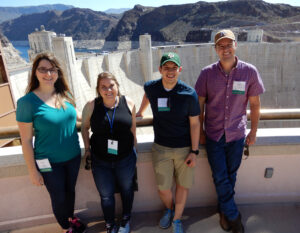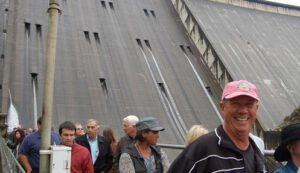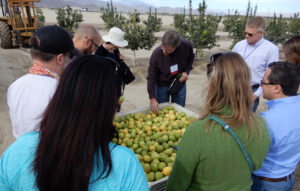The Water Education Foundation has been educating water professionals and the general public in California and across the Colorado River basin for more than 40 years. Its tours, conferences, publications, and online resources make the complex world of western water more easily comprehensible while also highlighting the high stakes of the issues involved.
In this interview, Executive Director Jennifer Bowles tells Irrigation Leader about the foundation’s history, its current activities, and its importance for the irrigation audience.
Irrigation Leader: Please tell us about your background and how you came to be in your current position.
Jennifer Bowles: I was a journalist for much of my career, first at the Associated Press in Los Angeles and later at a newspaper in Southern California, where I spent a lot of time covering water issues. In addition, I had been a Scripps fellow at the University of Colorado, Boulder, for a year, studying water law and policy at the law school. When I was a newspaper reporter, I took a tour of the lower Colorado River with the Water Education Foundation, which is how I first became aware of the organization. The then executive director sent me one of the foundation’s California water maps after that tour, and I hung that map everywhere my desk was moved in the newsroom because of how much it helped me to understand water issues in California. It showed where the water came from and where it went—which is sometimes hundreds of miles away. The foundation strives to be extremely neutral and impartial in everything it does, including in writing its water news, so I think my journalism background and my writing and editing skills were an important factor in my being hired by the board 6 years ago.

Irrigation Leader: Please tell us about the foundation and its history.
Jennifer Bowles: The foundation was founded in 1977, in the middle of a bad drought in California. At the beginning, it had a small staff—one person, for the most part—and worked primarily on its Western Water news magazine. But we eventually grew and began hosting conferences because it was clear to my predecessor that the various stakeholders needed a neutral place to discuss the often thorny issues associated with water. We also started running tours and creating those beautiful educational maps of California water regions. The 1990s were a key time for the foundation. That’s when we became the California coordinator for a national program known as Project WET, which stands for Water Education for Teachers. With that program, we began to organize workshops across the state to train educators on how to teach lessons on water in the classroom. During the 1990s, we also started a 1-year leadership program for the various stakeholder groups known as Water Leaders; today, there are more than 400 graduates of that program. In 1997, we also started our Colorado River Project and began applying many of our programs in California to the Colorado River basin, which is a key water source for Southern California. We started programs, wrote news articles, and started planning a lower Colorado River tour. Most importantly, we began holding a high-level Colorado River Symposium every 2 years, which brought together people from all seven states that rely on the river, Mexico, and tribal nations to discuss how to best manage the resources in this major western watershed.
Irrigation Leader: How many staff does the foundation have today?
Jennifer Bowles: Today, the foundation has about 10 staff, most of them full time. We also work with a freelancer who puts together our water news aggregate, Aquafornia, every weekday. Most of our team has a background in either teaching or journalism.
Irrigation Leader: How is the foundation funded?
Jennifer Bowles: We’re funded by donations from a wide variety of people and organizations, and we also apply for grants for specific projects. We also get some money from sales of our water maps, guides on water topics, and other educational materials.
Irrigation Leader: Is the foundation active primarily in California and the seven Colorado River basin states?
Jennifer Bowles: That’s right. We have been based in Sacramento since we were founded in 1977, and we’re active across California and the Colorado River basin.
Irrigation Leader: Who are your target audiences?

Jennifer Bowles: Our audience is anyone who wants to learn more about water. I like to describe the foundation as the Switzerland of the California water world—we’re pretty much the only neutral organization, and everyone is invited to our table. We offer a diversity of voices on water issues in whatever we do, whether it’s a tour, a conference, our news articles, or our leadership program. Our target audiences include farmers, environmentalists, urban dwellers, water rights lawyers, engineers who work on water projects, and the employees of state and federal agencies that are involved in water management across the West. Through our programming, we raise awareness of water issues but also seek to catalyze the critical conversations about water that are needed to manage the resource wisely.
Irrigation Leader: What are your main programs?
Jennifer Bowles: Our main programs today are our tours, our online Western Water news, and our maps and printed guides on key water topics. We also run an annual water summit in Sacramento, Project WET workshops, our Colorado River Project, and our yearlong Water Leaders professional development program. Our priority over the
last 2 years has been using social media to reach a wider and more diverse audience and putting more of our staffgenerated water news online. Our Western Water magazine used to be a printed magazine, but a few years ago we took it online, which gives more people the ability to read about water issues as newsrooms continue to shrink. We have the necessary expertise to generate that news, and we want to share it with as many people as we can. Going forward, we want our website to be even more of an educational tool than it already is. We’d like to create more interactive online learning tools in addition to Aquapedia, which is an online water encyclopedia.
Irrigation Leader: Please tell us about your tours. Who goes on them and how do you choose the destination and the speakers?
Jennifer Bowles: We hold six to eight public tours a year. Some are 2 days and some are 3 days. We do bus tours to our major regions every year. One of those annual tours is the Bay-Delta tour, which includes both the Sacramento– San Joaquin Delta, which is the hub of California’s two major water projects, and San Francisco Bay. Tour participants actually go across the bay in a boat during that tour. We do another annual tour across central California’s San Joaquin Valley south of Sacramento, and another tour north of Sacramento across the Sacramento Valley, which includes the big dams like Oroville and Shasta. We also tour the lower Colorado River every year. That tour essentially starts at Hoover Dam and ends in the Coachella Valley in California, taking in the lower basin states of Nevada, Arizona, and California. In the last few years, we have done a headwaters tour to emphasize the importance of the upper watershed and the Sierras with respect to water statewide. That tour goes from Sacramento to Lake Tahoe and back. We also do tours every year based on important topics of the year, such as drought or groundwater. For instance, we did a San Diego tour when the big ocean desalination plant opened in Carlsbad a few years ago.
The tour participants encompass a wide array of people, including farmers, environmentalists, employees of nongovernmental organizations (NGOs) that work on water issues, water district employees and board members, lawyers, engineers, scientists, water managers, and employees of the California Department of Water Resources and the Bureau of Reclamation. Those agencies use our tours as a training ground for their newer staff.
We choose speakers for our tours based on the region and focus of the tour, but we always strive to include a diverse set of voices wherever we go.

Irrigation Leader: Do you have a rough estimate of how many people participate in all your tours every year?
Jennifer Bowles: Probably around 350. The Bay-Delta tour alone has about 100 participants and requires two buses.
Irrigation Leader: Who are the participants in your training programs?
Jennifer Bowles: It’s the same wide array of folks who come to all our events—lawyers, engineers, scientists, people from NGOs, farmers, people who work at water districts or irrigation districts, and people from the state and federal agencies that manage water in the West. Like I said, we’re the Switzerland of the California water world—everybody comes to our events. We take that reputation seriously and strive to remain neutral. I think that’s why people trust us as a resource.
Our Water Leaders program has more than 400 graduates. A strong theme of that program is learning other perspectives and getting out of your comfort zone. We match everybody in that program up with a mentor, usually someone with a completely different background, to help them come to understand water from a different perspective. We have seen graduates of that program move into top leadership roles in the water world, which is really satisfying.
Irrigation Leader: Who uses your books, maps, Aquapedia, and the other resources you create?
Jennifer Bowles: Our Layperson’s Guide series—which includes books on groundwater, California water, and water rights—are used by universities, which we know because we suddenly get a lot of orders as the semesters start. We know that professors use them, which is part of the reason we keep them in a print version. I have had people tell me that when they first came to California after getting hired by a water engineering firm or law firm, they went through our whole collection of water guides. I’ve heard that story over and over again. Water issues in California are probably more complicated than in any other state, and our publications are a good resource for getting your arms around the issues.
Irrigation Leader: Which of your programs are most relevant for farmers and irrigators?
Jennifer Bowles: Many of our tours go through major farming regions, including the Imperial, Palo Verde, and Coachella Valleys, which all use Colorado River water; California’s Central Valley; and the Sacramento–San Joaquin River Delta. We’re always striving to tell the story of agriculture as part of the overall water story, so every tour has some agricultural aspect to it. We write a lot about agriculture in our Western Water news, which, as I mentioned, is fully available online. Some of our Layperson’s Guides focus specifically on agriculture-related water topics such as groundwater; agricultural drainage; and the Central Valley Project, the federal infrastructure project that brings water from Northern California to many farms in the state. Our groundwater map is also popular in the agricultural world, which uses groundwater heavily. In addition, when the Sustainable Groundwater Management Act (SGMA) was passed in California in 2014, we received a grant to work on a handbook to help people understand the new law and how it was being implemented. SGMA’s first targets were critically overdrafted basins, many of which are in the major farming region of the San Joaquin Valley.
Irrigation Leader: Do you work directly with irrigation districts?
Jennifer Bowles: I’m not sure we can say we work directly with them, but many of them support our work and have served on our board of directors. Right now, the Palo Verde Irrigation District, located along the Colorado River, is represented on our board. We always try to have some farming element on our board. We have a couple of farmers on our board who speak regularly at our events, including on our water tours. A lot of irrigation district employees attend our tours as well and participate in our yearlong Water Leaders program. We interact with irrigation districts and farmers all the time, and they attend our events regularly.
Irrigation Leader: What is your vision for the future of the foundation?
Jennifer Bowles: We want to put more of our materials online and create more interactive learning tools. We want to expand our programs even more across the Colorado River basin. We want to keep making a difference by bringing in diverse voices and helping people understand the water story so the differences can be resolved and the resource managed wisely.
Jennifer Bowles is the executive director of the Water Education Foundation. She can be contacted at jbowles@watereduation.org.
